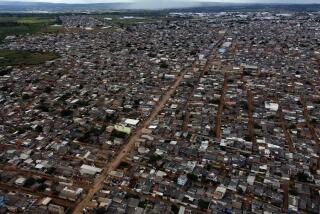Life in Remote Village Changes Dramatically
- Share via
SERRA DO TALHADO, Brazil — Three years ago, Serra do Talhado and countless other hamlets across Brazil’s poorest region seemed destined to reach the end of the millennium as they had begun it: with no electricity or water service.
In Brazil’s northeast, electricity consumption was rising 8% a year. Four hydroelectric dams along the major waterway, the Rio Sao Francisco, were at capacity.
So the state government signed on to the Renewable Energy Rural Electrification Project at the 1992 Earth Summit in Rio de Janeiro. It put up 30% of the $500 million needed, the 800 municipalities chipped in 10%, and the World Bank financed the rest.
Technicians installed a voltage regulator, 12-volt battery and 17-volt solar panel outside each of Serra do Talhado’s eight mud-and-straw huts. A wind-powered water pump went up near the fields.
It cost $500 to install each solar system, one-fourth the cost of running power lines from an electrical grid. And the wind turbines turn out electricity for $57 a megawatt, $3 cheaper than hydroelectric power. There’s no cost to residents.
Dramatic changes followed.
Simone Araujo Denise used to walk 15 miles each week to the nearest town, Mirandiba, to fill five quart bottles with kerosene for the two lamps that lighted her hut.
Like most people in Serra do Talhado, Araujo, 23, never learned to read or write. As a child, she helped her parents work their corn and rice fields by day. At night, when she had time to study, there was no electric light to read by.
Today she and her daughter are learning to read together at night under three fluorescent lights fed by the dark crystalline solar panel outside her window.
“When the sun goes down, I sit with my daughter to read of different places,” said Araujo, who then laughed. “We travel far in the books.”
More to Read
Sign up for Essential California
The most important California stories and recommendations in your inbox every morning.
You may occasionally receive promotional content from the Los Angeles Times.













